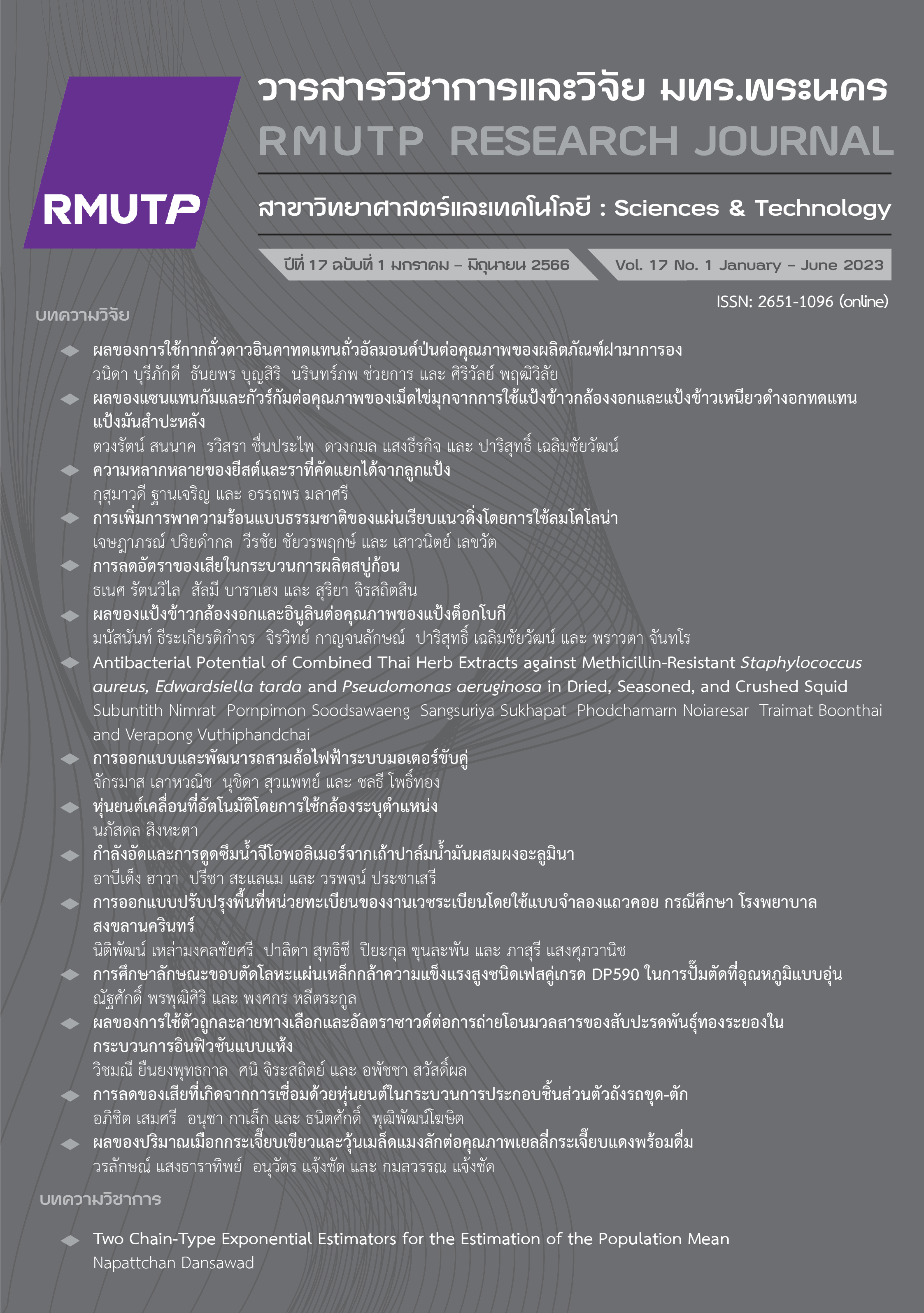Reducing Waste Generated by Welding Robots in the Assembly Process of Backhoe Body Parts
Main Article Content
Abstract
This research aimed to reduce waste caused by welding robots in the assembly process of backhoe body parts. The researchers used 7QC tools: Check Sheet, Pareto Diagram, Cause-and-Effect Diagram and Graphs, to find out causes and solutions. The study revealed that the greatest amount of waste occurred at the robotic assembly process. When using Cause-and–Effect Diagram to analyze the assembly process, it indicated that the problems were caused by 2 factors: machines and workforce. There are 3 drawbacks of machines: dirty welding head, not straight welding line, and lack of precision while welding. The second factor, people, made mistakes by not being able to place the work pieces at the right spot. To solve the problems, firstly, the research team created a manual for robot maintenance. Secondly, we inform employees how to maintain the machines to prevent problems with the entire robot's components. In addition, we prepared a jig for holding the work pieces while welding to solve problems related to robotic welding. The findings and compilation of data showed that the amount of waste from the welding process collected between June and July 2020 was 47.79%. When comparing data after improvement during August to September 2020, the amount of waste reduced to 12.34%. It was obvious that this improvement reduced the waste generated from robotic welding in the assembly process of backhoe body parts up to 74.18%.
Article Details

This work is licensed under a Creative Commons Attribution-NonCommercial-NoDerivatives 4.0 International License.
ลิขสิทธ์ ของมหาวิทยาลัยเทคโนโลยีราชมงคลพระนครReferences
B. G. Chandankar† and V. M. Chapte, “Productivity Improvement in Welding Robot,” International Journal of Current Engineering and Technology, pp. 251-254, Oct. 2016.
M. Supawat and P. Jirawat, “Defects Reduction in Metal Parts Production Process,” Kasem Bundit Engineering Journal, vol. 6, no. 1, pp. 91-106, Jun. 2016.
C. Khunponkaew, Productivity Improvement Principle, 1st ed. Bangkok: Prachachon Publisher. Thailand Productivity Institute, 2001.
S. Tangphaitoon, 7 Waste Reduction by Kaizen for Production Improvement, 1st ed. Nonthaburi, 2004.
R. B. Chase, Production and Operations Management, 7th ed. McGraw-Hill, 1995.
K. Pipatpanyanukul, Quality Control, Top Textbook, 2014.
S. Nataphan, Quality Control, SE-ED Textbook, 2008.
G. S. Hegde, A textbook on Industrial Robotics, University Science Press, 2008.
M. Mali and K. Inamdar, “Effect of Spot Weld Position Variation on Quality of Automobile Sheet Metal Parts,” International Journal of Applied Research in Mechanical Engineering (IJARME), vol. 2, pp. 23-27, 2012.
N. Ma, H. Huang and H. Murakawa, “Effect of jig constraint position and pitch on welding deformation,” Journal of Materials Processing Technology, vol. 221, pp. 154–162, Jul. 2015.
C. Chakrad, S. Nattakorn and D. Phattharaphong, “Waste reduction in welding process of automotive suspension,” RMUTL Journal, vol. 7, no. 1, pp. 28-141, Jun. 2014.
A. Kitsutipong and P. Akkharaprathomphong, “Failure Reduction in welding process for Automotive Seat Frame,” Research and Development Journal, vol. 23, no. 1, pp. 84-92, 2012.
K. Ploypanichcharoen, Principle of Quality Control, Technology Promotion Association (Thailand-japan), 2007.
C. Surasak and K. Rapee, “Product quality improvement in plastic injection process by statistical quality control,” in Proceeding of 15th RSU National Graduate Research Conference, Rangsit Univesity,Thailand, 2020, pp. 2369-2381.
W. Jirawat, “Waste reduction in a manufacturing process: A Case Study of dadear Ceramics Factory in lampang provice,” RMUTP Research Journal, vol. 10, no. 2, pp. 43-53, Sep. 2016.
T.Manop,Preventative Maintenance Items for Industrial Robots, Technology promotion Mag, vol. 36, no. 207, pp. 31-34, Nov. 2009.
T. Poovanart and T. Chark, “The Comparative Study on Operation Processes and Project Management Body of Knowledge: A Case Study on a Jig Production for the Robotic Welding Machine,” EAU HERITAGE Journal Social Science and Humanity, vol. 7, no. 2, Aug. 2017.
W. Methong, Jig and Fixture Design, Technology Promotion Association (Thailand-japan), 2008.
K. Onuma, S. Arkhom, J. Ratchanikorn and S. Worlaluck, “Work Instruction Preparation and Jig Construction for Product Inspection in Bracket Production Process Case Study: SPE Enterprise Co., Ltd,” IE Network Conference, Preparation Summary, Thailand, 2012, pp. 476-484.


